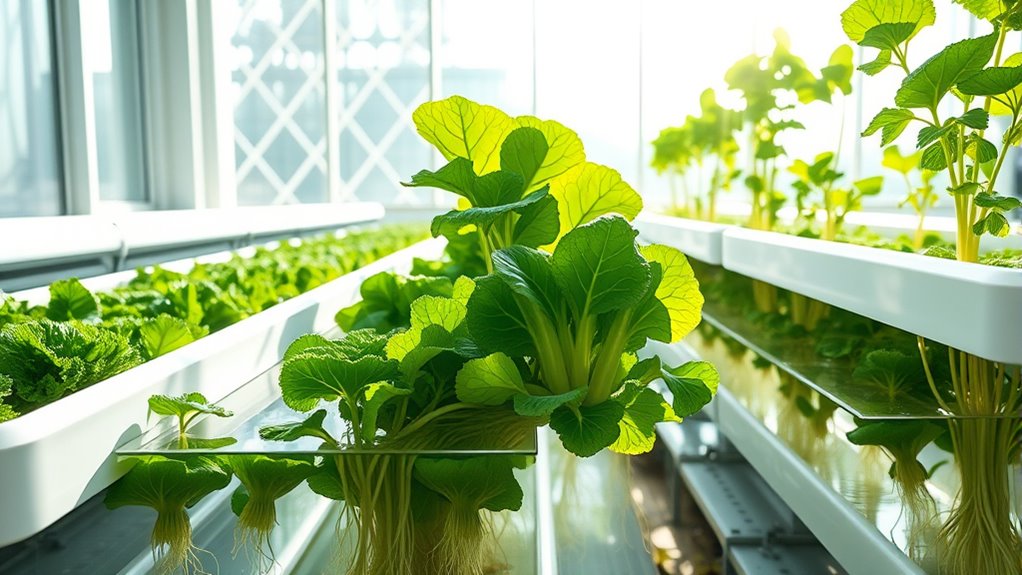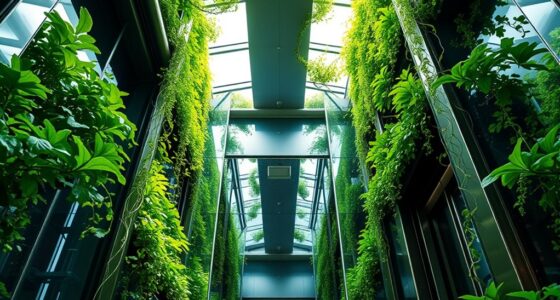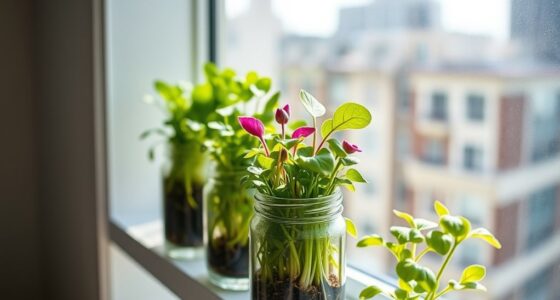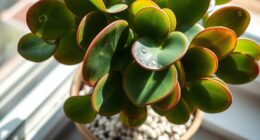Hydroponics lets you grow fresh vegetables indoors or on small balconies without soil, making city farming simple and efficient. You’ll set up a system with a container, nutrient solutions, and a water pump, which can even be automated. It’s perfect for compact spaces and helps you produce healthy, pesticide-free produce year-round. If you keep exploring, you’ll discover how to optimize your system and enjoy the benefits of soil-free urban gardening right at home.
Key Takeaways
- Hydroponics allows urban residents to grow vegetables indoors or on balconies without soil.
- It uses nutrient-rich water solutions and simple setups suitable for small spaces.
- Maintaining proper nutrient levels and environmental conditions ensures healthy plant growth.
- The system minimizes pests and soil-borne diseases, reducing pesticide needs.
- Indoor hydroponics offers year-round fresh produce, maximizing limited urban space efficiently.
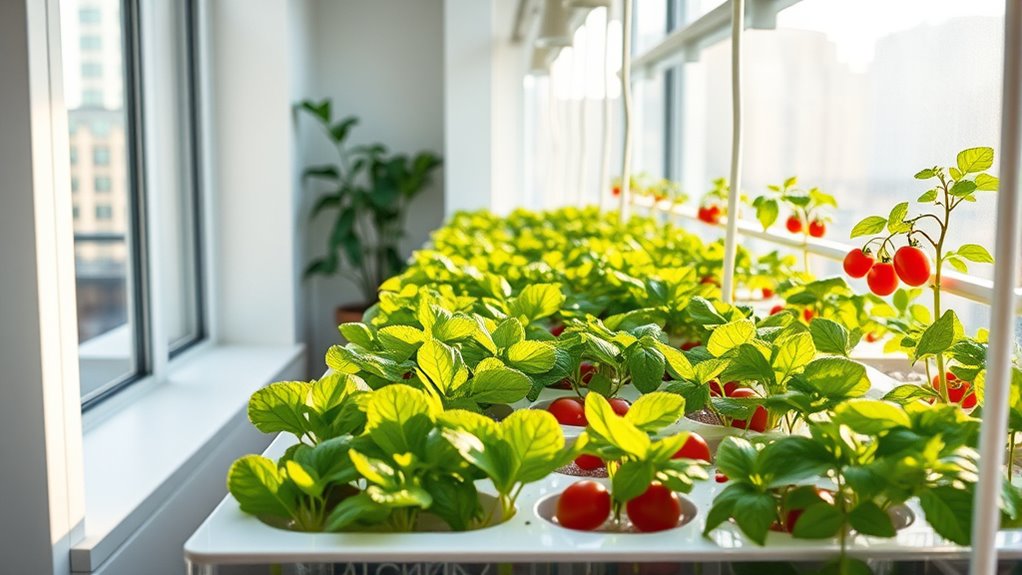
Have you ever considered growing your own vegetables without soil? If you’re living in the city and feeling limited by space, hydroponics offers an innovative way to immerse yourself in urban gardening. This method allows you to cultivate fresh produce right in your apartment or balcony, using nutrient solutions instead of traditional soil. It’s an efficient, clean, and sustainable way to enjoy homegrown vegetables, even in tight spaces.
Hydroponics at home involves growing plants in a controlled environment where nutrients are delivered directly to the roots through water-based solutions. You don’t need large garden beds or outdoor plots—just a small setup that fits your available space. Whether you opt for a simple container system or a more advanced hydroponic kit, you can tailor it to your needs. The key is understanding how nutrient solutions work: they contain the essential minerals and elements plants need to thrive, such as nitrogen, phosphorus, and potassium. These solutions are carefully formulated to promote healthy growth, ensuring your plants receive everything they require without soil.
One of the biggest advantages of urban gardening through hydroponics is the ability to regulate environmental factors. You can set the right pH level, temperature, and light to optimize plant growth. This control minimizes pests and diseases commonly found in soil-based gardening, reducing the need for pesticides. Plus, since you’re using water and nutrient solutions, there’s less mess, and you can keep your growing area clean and organized. It’s a smart way to make use of limited space while still producing a variety of vegetables like lettuce, herbs, tomatoes, and peppers.
Setting up your hydroponic system is simpler than you might think. You start with a container to hold the nutrient solution, a pump to circulate the water, and a growing medium—such as coconut coir or clay pellets—to support your plants. Regularly monitoring and adjusting your nutrient solutions guarantees your plants get the right balance of nutrients. Automated systems are available if you prefer a more hands-off approach, but even basic setups can be highly productive.
With a little attention and care, your urban gardening efforts can flourish indoors or on a balcony. Hydroponics makes it possible to grow fresh, healthy vegetables all year round, regardless of outdoor weather conditions. Incorporating high efficiency systems can further boost your yields and save resources. It’s an eco-friendly, space-efficient way to enjoy the satisfaction of harvesting your own food—right in the comfort of your city home.
Frequently Asked Questions
What Are the Initial Costs for Starting a Home Hydroponic System?
Starting a home hydroponic system costs vary, but you should budget for essentials like hydroponic lighting and plant support systems. You’ll need grow lights, which can range from affordable LED setups to more advanced options, and support systems like net pots or trellises. Additional costs include nutrient solutions, containers, and pumps. Overall, expect to spend around $100 to $500, depending on the size and sophistication of your setup.
How Much Space Is Needed for Effective Urban Hydroponic Gardening?
Think of urban hydroponic gardening as planting a lush jungle in your apartment’s corner. You don’t need a sprawling backyard—just enough space for vertical farming and smart space optimization. Even a small balcony or unused wall can become a thriving garden. With the right setup, you’ll maximize your yield in minimal space, transforming tight quarters into a green oasis where plants flourish upward and outward.
What Common Pests or Diseases Affect Hydroponic Plants Indoors?
You should be aware that common pests like spider mites, aphids, and fungus gnats can affect indoor plants, even in hydroponic setups. Indoor diseases such as mold, root rot, and bacterial infections may also develop if humidity levels are too high or if you don’t maintain proper hygiene. Regular inspection, good airflow, and keeping your equipment clean help prevent these issues, ensuring healthy, thriving hydroponic plants indoors.
Can Hydroponic Systems Be Automated for Easier Maintenance?
They say “a stitch in time saves nine,” and when it comes to hydroponic systems, automation can save you time and effort. You can set up automated monitoring to track nutrient levels, pH, and water temperature, ensuring ideal plant growth. Plus, robotic harvesting takes the strain off manual labor. With these innovations, maintaining your indoor garden becomes easier, so you can enjoy fresh produce without the hassle.
How Do I Troubleshoot Nutrient Deficiencies in My Hydroponic Setup?
When troubleshooting nutrient deficiencies, start by checking your pH balance, as it affects nutrient uptake. If your plants show signs of deficiencies, use a reliable nutrient monitoring system to measure levels accurately. Adjust the pH and nutrient concentrations as needed, ensuring your system stays within ideal ranges. Regular monitoring helps you catch issues early, preventing deficiencies from worsening and keeping your plants healthy and productive.
Conclusion
Think of your home hydroponic setup as a tiny garden in a glass jar, thriving without soil, just like a secret oasis waiting to be discovered. With each plant you nurture, you’re planting seeds of innovation and sustainability right in your own space. As you tend to your indoor garden, remember you’re cultivating more than just vegetables—you’re growing a future where city life and nature bloom side by side. Your green sanctuary is ready to flourish.
